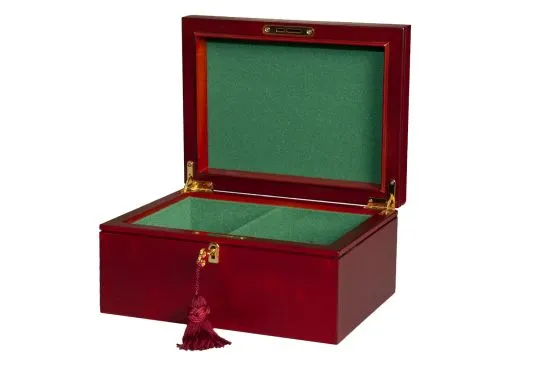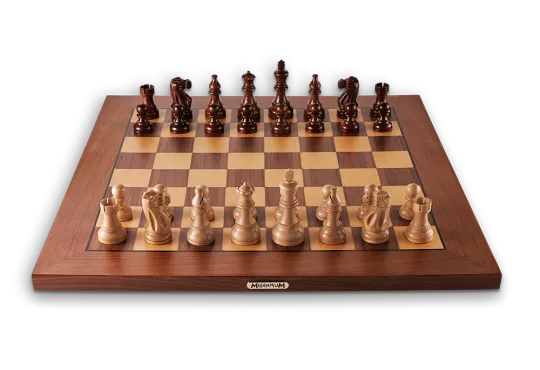The Best Chess Strategy for Beginners
What is the secret to winning more chess games? Is there one strategy that is the best chess strategy for beginners? One that beats the rest? While chess is a bit more complicated than that, there are some strategies that beginner chess players can implement to win more games, and we all want to win more games!

Table of contents
What is a Chess Strategy
Chess is a game of deep strategy. If you are new to chess, there are a few simple strategies that you can use to give you an edge against your opponents. Once you know all the rules, you can learn basic tactics and strategy.
Difference Between a Tactic and a Strategy
A chess tactic is usually one move that gains some sort of advantage. Usually, a tactic wins material, improves your position, or leads to a checkmate. A tactic often takes advantage of a weak king and uses a check. A classic example of a tactic is the double attack or fork. An example of a fork would be a forcing move where one piece is attacking the king as well as another undefended piece.
A Strategy
A chess strategy is deeper than one move or one tactic. Sometimes the best chess strategy for beginners can be built around the possibility of a tactic, though. If you are not sure what to play, but see the possibility of a fork a few moves from your current position, that can become a strategy! Chess strategies can be looked at in different parts of the game, the opening, the middle game, and the endgame. But the most important “strategy” for beginners is to not blunder!

The Best Strategy for a Beginner: Not Blundering
No amount of chess knowledge or strategy can win you a game if you are blundering your pieces. Blunders can completely change the game. Even if you play a near-perfect chess game for fifty moves, one blunder on move fifty-one will lose you the game. Learning chess strategy is good, but if you find yourself regularly blundering in your games, I would focus on reducing those mistakes. The best chess strategy for beginners is to not blunder!
-
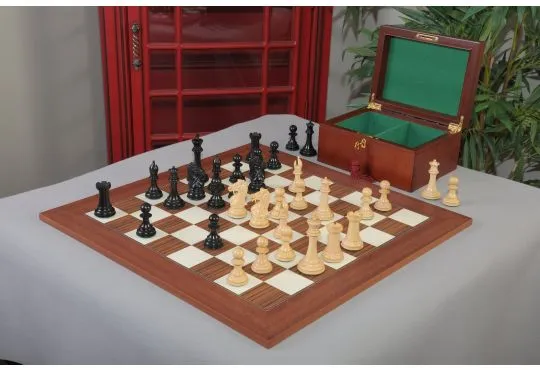 Free Worldwide Shipping
The Leicester Series Chess Set, Box, & Board Combination Enjoy Savings of 31% Off MSRP When Purchased as a Combination
Free Worldwide Shipping
The Leicester Series Chess Set, Box, & Board Combination Enjoy Savings of 31% Off MSRP When Purchased as a Combination$797.95
Starting at $569.00
To $648.95
-
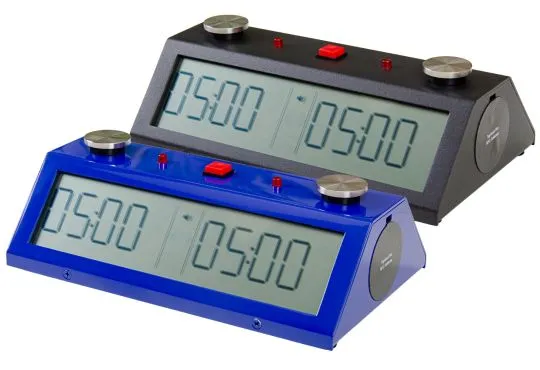 Tap N Set Pro Digital Chess Clock The Official Chess Clock of the US Chess Federation - The World's Only Smart Phone Programmable Clock
Tap N Set Pro Digital Chess Clock The Official Chess Clock of the US Chess Federation - The World's Only Smart Phone Programmable ClockStarting at $124.95
To $129.95
How to Avoid Blunders
If you are blundering often, the best way to reduce your blunders is to ask yourself what your opponent will play, and then look at all the possible forcing moves and checks. If the move your opponent is going to play is to capture your hanging queen, then move it! Tunnel vision is a phrase used in chess to talk about when you only think about your moves. If all you do is think about your own moves, you may miss the checkmate your opponent is about to play.
Chess Openings: General Chess Opening Strategy
Once you have moved passed playing mostly blunders, then you can start studying some basic winning chess strategies. Chess strategies are often broken up into parts of the game. The first moves in a chess game are called the opening. Knowing solid opening principles can be the difference between having a winning and losing position.
Control the Center
The key to good opening principles starts with putting a pawn in the middle of the board and controlling the center. Central control and having central pawns with strong pieces will lead to good games with strong pawn structures. The best way to control the middle at the beginning of a game is by putting a pawn on e4 or d4. The two most common opening moves!
Developing Your Pieces
After putting a pawn in the middle of the board, then look to develop your pieces. How do you develop your pieces? Bring your pieces, starting with your knights and your bishops, off of their starting squares and into the game. If you leave your pieces where they start, it's almost like you don’t even have them! The benefit of having material is only apparent when you are using your material.
Castling
Once your pieces are out of the way, then you can get your pieces to safety by castling. Castling is when you move your king over two spaces and the rook goes on the other side. This keeps your king safe and reduces the chance of annoying tactics on your exposed king. You still have to watch out for checkmates, though.

A Strong Chess Opening Strategy Leads to a Strong Opening!
If you were able to put a pawn in the middle of the board, develop your knights and your bishops, and get your king castled, then you have played a good strong opening. Don’t forget to always ask the question that reduces blunders, “what will my opponent play?” If you don’t respond to your opponent's threat and just keep developing, you might lose material. Now you are on to the middle game.
-
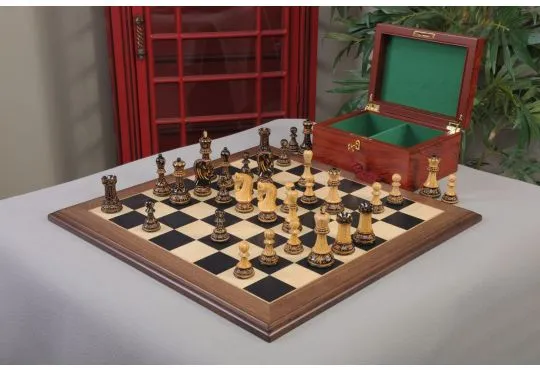 Free Worldwide Shipping
The Burnt Zagreb '59 Series Chess Set, Box, & Board Combination Enjoy Savings of 30% Off MSRP When Purchased as a Combination
Free Worldwide Shipping
The Burnt Zagreb '59 Series Chess Set, Box, & Board Combination Enjoy Savings of 30% Off MSRP When Purchased as a Combination$697.00
Starting at $489.00
To $568.95
Middle Game: Strategies for Beginners
Once you have completed the opening, a lot of beginners begin to feel lost. Basic chess strategies are like little road maps for the rest of your game. The middle game can be tough to navigate, but if you follow these basic ideas then you should be able to maintain the advantage you earned from your strong opening.
Making Your Pieces Happy
Most of the pieces on the chessboard have certain squares or situations where they excel. A bishop stuck behind pawns is not a very good piece. So if we have a piece that is not in a good position, look for ways to improve those pieces.

Bishops
Open diagonals and open positions are perfect for bishops. A bishop stuck behind locked-up pawns is not a happy piece. If you are stuck in a middle-game position and you are not sure what to do. Look to see if you can make a bishop better by moving it to an open diagonal or using a pawn break or pawn move to improve the bishop.
Rooks
Often rooks are not used until after you have finished the development of the rest of your pieces, but where should you put your rooks? Rooks like open files. A file is a vertical row on a chessboard. An open file is a file with no pawns. Black pieces can occupy open files and they still be open for white rooks. Pieces are much easier to move, though, and moving our rooks to an open file is key.
Taking Control of the File
Controlling a file is a bit like king of the hill, or capture the flag. You need to be the first one to capture that open file, and then you want to hold it down. So if you see an open file, don’t waste too much time, get your rooks there and seize control.

2nd and 7th Ranks
One reason rooks need to make their way to open files is so that they can control the 2nd and 7th ranks. If rooks like open files, they really like getting into your opponent's position on the 2nd/7th. Rook to d2 here takes control of the d-file but also prepares your rook to ender the 7th rank.
Knights
How should we be improving our knights? If white has a knight on the side of the board, or away from action, rerouting that white knight can be a great way to improve your position. Knights on the rim are dim. This may be a common saying, but it is true! Keep your knights off of the side of the board if possible. They attack half as many squares.
Chess Tips for Beginners: Active Pieces are Happy Pieces
Ultimately, we want to have active pieces. This means our pieces have targets, and mobility. The opposite of this would be our rooks on move one. They have no targets, and they have no mobility. That’s why we like getting our rooks to open files. A rook on an open file is active. It has more targets, even if that target is just the 2nd/7th rank, and it has more squares it can access.
Endgames: The Bain of Beginner Chess
Endgames, and endgame strategy, can often be the most difficult part of chess for beginners. These endgame positions often look like they should be more simple, but they are deceivingly complicated. Learning and knowing the very basics of endgame strategy can be what changes a loss to a win. We will look at the best chess strategy for beginners in the endgame.
Basic Endgame Strategy
There are many resources to learn the basic theoretical endgames that a player might often come across. If you still need to learn how to convert a number of the very basic winning endgames, then working through those will greatly improve your play. If you play a perfect game and get to a winning queen-king checkmating position but do not know how to convert, it would all be for nothing!
How to Learn Endgames
I would start with some online resources let let you practice these basic endgames over and over. Using chess.com’s endgame trainer is an excellent method for that kind of basic improvement that will easily add hundreds of ELO to your ratings. There are other books available also to teach you basic endgame positions. Outside of those practical basic endgames, knowing the best chess strategy for beginners in the endgame can help you get to those technically winning positions.

King Activity
If you are not sure how to proceed in an endgame, and you have not yet activated your king, that might be a good option. Your king is a very important piece in the endgame and we want it into the middle of the board to be as useful as possible.
Promote Your Pawns!
I am always amazed at how many players will have a completely winning endgame if they just push their pawns, but shuffle their pieces instead. Pawns are often the key to winning an endgame, so don’t forget about them. A passed pawn, a pawn with no pawns opposing it on its file or adjacent files, is incredibly strong.
Piece Activity
Just like at the beginning of a game, make sure your pieces are on active squares. If you have a queen but it is being tied down to the defense of a pawn, try to find a better use of that material. Especially if you are up material on your opponent and you are trying to convert, use that extra material. I see so many students trying desperately to checkmate with just their queen when they are also up two rooks. Use your material!
The Best Chess Strategy for a Beginner: Keep Playing
Playing chess is hard. Practicing all of these opening, middlegame, and endgame strategies is not easy. You may make mistakes. Keep practicing, and when you are not sure of what move to play, just avoid blunders and try to improve your pieces. But most importantly, play chess!
Frequently Asked Questions
A tactic is generally just a few moves to win material or checkmate while a strategy is generally more of a plan for your play.
Focus on learning to not blunder your pieces, and then some basic opening, middlegame, and endgame strategies from there.
If you need a plan in a chess game, first make sure you are not blundering anything, then look to improve your pieces!
Get your rooks to open files and to the 2nd and 7th ranks.
Practice your basic endgames and checkmates online until you can do them consistently! Then make sure you are following basic endgame strategies like controlling the middle with an active king, and making sure you have active pieces.



